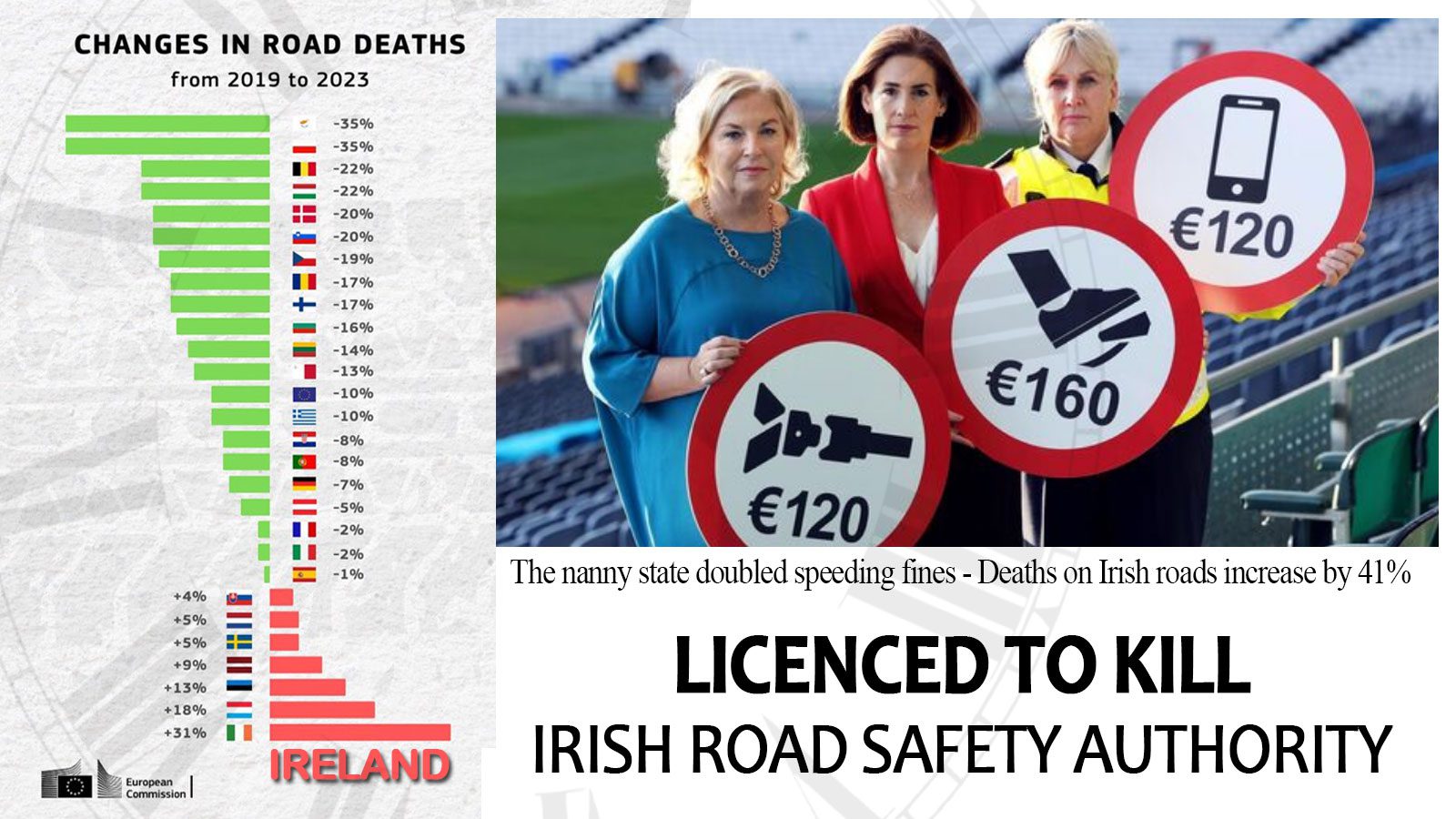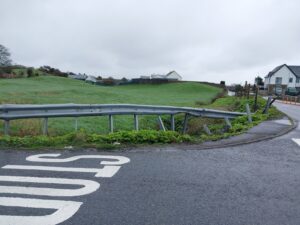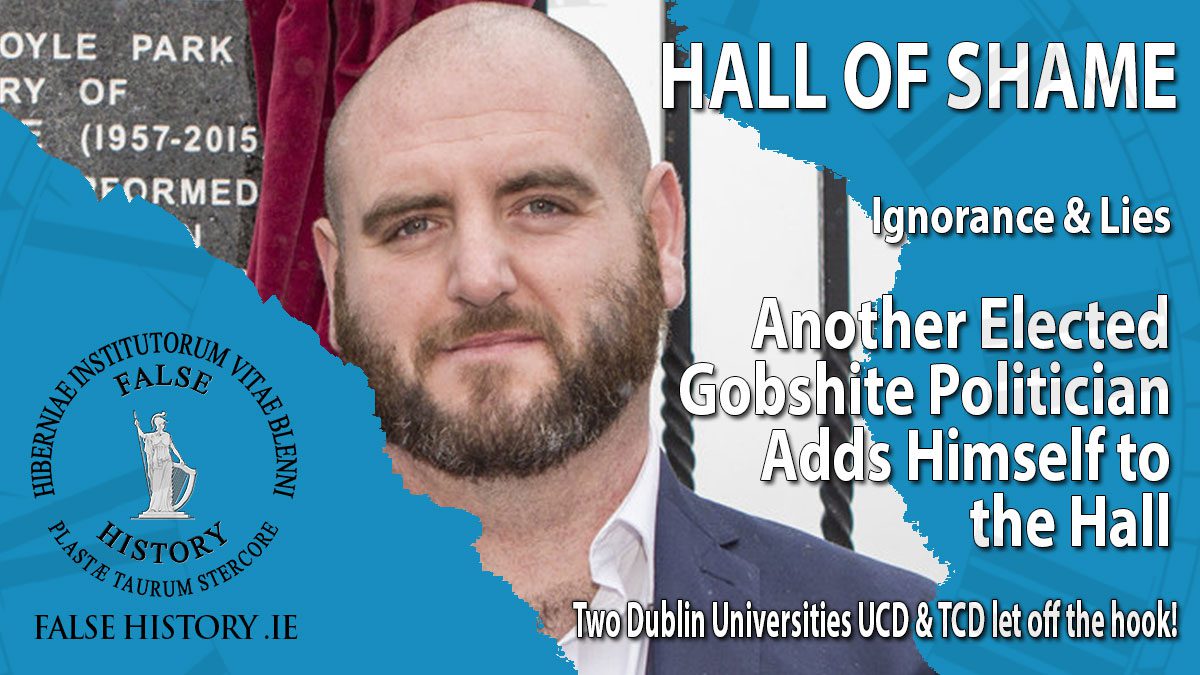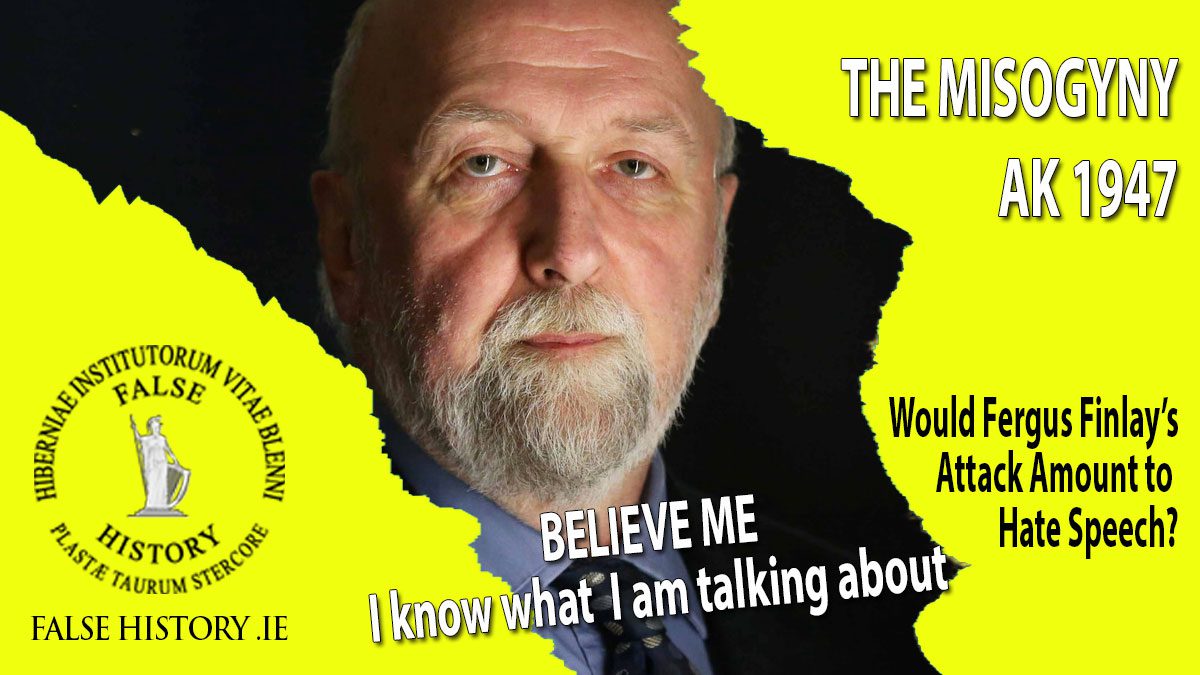The Irish Road Safety Authority (RSA) was set up to fail and has proved its impotence through the recent rise in the number of road fatalities. At a fundamental level, the failures of the RSA are due to a single foundational false premise. As an illustration, consider the response of the government to combat the rising trend in road deaths in 2022. The Minister for State at the Department of Transport, Hildegard Naughton doubled speeding fines in October of that year. As a safety strategy it was a total failure because the number of deaths for 2023 on Irish roads increased by nearly a fifth. Moreover, when measured over two years, the increase was a staggering 41%. That should have set alarm bells ringing at government level and prompted an investigation into the operation and effectiveness of the RSA, but nothing happened.
A big clue to finding the single false premise is to look at composition of the board of the RSA and their qualifications. The board is chaired by Liz O’Donnell, a former politician and law graduate. Dr. Derek Cawley, a surgeon and Dr John Cronin is an emergency medicine consultant. Sarah is Johnson, a lawyer with claimed expertise in public contracts and procurement. Ashling Cunningham is an experienced chief information officer at Irish Life Group, Dónall Curtin, described as an experienced accountant, and finally Dave Montgomery is also an accountant. That’s it! A board comprised of doctors, lawyers, and accountants with not one single person with expertise in safety. [i] Is that fact not surprising!
The global safety industry is populated with well-intentioned people who think safety planning and strategy is easy and intuitive. Consequently, incompetence is rife throughout the discipline of safety regulation and governance, but perhaps troublingly, that includes its most competent arena, aviation safety.
Princess Dianna is certainly one of the most famous road fatalities in history, but her death was entirely due to poor quality road safety management. The road crash that led to her death had other causal factors whereupon the public gaze has been directed. It might appear cynical, but it is all too common to witness various authorities apportioning blame for causing accidents to drivers, to avoid accepting any blame landing on their shoulders. When investigators are only concerned with apportioning blame to people, it should trigger warnings that their analysis is likely to be inept. As their sole focus is on punishment, they can play no role in the prevention of future accidents.
Aviators have a motto, “aeroplanes bite fools”, meaning that incompetence is rapidly exposed. However, a second aviators’ motto holds that humans are not well suited to the anticipation of potential dangers, “the lessons of safety are learnt in the graveyard”. As an example, take the two 737 Max crashes, they exposed the many “fools” working not only for Boeing but for the regulatory safety authority, the FAA. The use of the common term “fool” in the aviators’ proverb might lead you to believe that aeroplanes only bite stupid people but that could not be further from the truth. Read the crash investigation reports into the two space shuttle disasters and note that many highly educated and qualified people made some very silly and elementary errors that led to the loss of multiple lives.
For those who are interested in, and study safety, it begs the question, why do humans only start to learn lessons after the graveyards have started to fill up with victims? Victims whose deaths were easily preventable, in hindsight.
The 737 Max crashes are a classic in the genre of “graveyard engineering”, as it is sometimes called. In October 2018, a brand-new aircraft, flown by Lion Air crashed into the sea killing 189 people, but nothing much more than the normal air crash investigation took place. However, within five months, when another new 737 Max airliner, belonging to Ethiopian Airlines, plunged into the ground killing another 157 people, it exposed many weaknesses and failures within aviation safety management. In contrast, in the aftermath of the second crash, the action was swift and decisive. All 737 Max aircraft were grounded by various aviation regulatory authorities across the globe.
The lessons of aviation safety are forced by circumstance to be learnt quickly and acted upon with due haste. It is a process that naturally purges the incompetents and foolish processes out of the system. On the other hand, road safety affords incompetence its most luxurious refuge.
Safety regulation is not intuitive. Aviation safety has learnt that human intuition has no place within the industry, yet it pervades in places and sometimes dominates. Humans will always make mistakes but many of these mistakes can be predicted, enabling measures to be put in place to prevent or lessen their consequences.
That is the fundamental false premise that the RSA is founded upon. The government simply plucked people out of nowhere using the false assumption that safety regulation is intuitive, and that no specialist expertise is required to guide strategy and policy.
Accordingly, the primary road safety strategy of the RSA is nannyism. Evidenced by the high frequency of condescending advertisements, scolding road users, as if they were bold children. When the number of fatalities rises, they simply increase the frequency of output hoping that it might brainwash road users into adopting safer behaviours.
One recent road accident resulting in multiple fatalities was reported to have occurred at a known accident blackspot. The elimination of accident blackspots should have been the first priority of the RSA when it was founded in 2006. These blackspots are places where the road engineering is deficient. Places where, in certain circumstances, even good conscientious drivers can have a crash. That is a major point, deficient road engineering is responsible for many accidents and deaths on Irish roads. It seems to be of little concern to the RSA, or any of the local authorities, or even the government at national level.
I recall one case where a driver shot through a crossroads and was T-boned by a car on the main road. He, along with his girlfriend and their toddler died. Within days, the locals reported that the junction was unrecognisable after the local authority carried out works. Prior to that, the signs warning of the junction ahead were obstructed with overgrown vegetation, while the white lines were worn off the road. The driver thought he was on the main road and had no warning that he was approaching a junction without priority. Galway County Council were entirely responsible for their deaths but was anyone held accountable?
Similar accidents continue to occur and many people have been wiped out at straight through crossroads. Not far from the scene of the aforementioned accident is Carnmore Cross. It was once known locally as “suicide cross”. It was a straight through crossroads on the main road from Galway City to Monivea. The junction layout cost many lives until the council decided to stagger the crossroads. Subsequently, drivers approaching from the non-priority ends had no vision of the road ahead and could not mistake it for a straight through road.
A stone’s throw away is the much newer Oranmore bypass, a dual carriageway where once again poor safety engineering caused the death of a woman. The cause of her death was due to the Armco steel barriers giving way, allowing the car to plunge over an embankment into a field. In Ireland these barriers are mere window-dressing, installed to masquerade as safety devices but will collapse when hit with a child’s pram travelling at 5kph. (See appendix)
Judging by the numerous editorials, especially after a spate of fatal road accidents, it seems that every newspaper editor considers himself/herself to be an expert in road safety. How many of these articles have laid the blame on local authorities for inadequate safety management. Is this the reason that local authorities get away with killing people? The focus is always on the incompetence of road users.
Think of all the commentary surrounding the death of Princes Dianna who died as a result of her car striking a pillar in the Pont de l’Alma tunnel in Paris. Did anyone complain that there were no crash barriers. Had the pillars been protected by a concrete crash barrier there is no doubt that the consequences of the accident would not have been as serious. The car would have bounce off it and may have bounced multiple times between two barriers on opposite sides of the road. Motorsport fans are well used to seeing cars bouncing off barriers in such a manner. Each meter travelled before coming to a halt, even upside-down, is causing the car to slow down and dissipate its energy before it finally stops. The13th pillar in the tunnel had the opposite effect, it concentrated the full energy into one sharp point, stopping the car in just over one metre. It resulted in a force of seventy times that of gravity (70g), being transferred brutally in milliseconds to the occupants of the car. To put that in perspective, a human heart weighs on average about 285g for a female and 290g for a male. That’s at 1g. Simply multiply the weight by the g-force number and a human heart will strike the rib cage with a force of 20 to 21kg.
In 2021, Max Verstappen collided with another car and left the track at 290kph/180mph at Silverstone. The onboard instruments measured the impact at 54g. Verstappen emerged shaken but unhurt, thanks to good safety engineering. All corners of the track have a safety run-off area made of tarmac that helps to decelerate the car, better than grass, even when spinning. When the tarmac runs out, a gravel pit followed to further slow a vehicle before it hit the final barrier. Even then, the barrier was cushioned with six layers of tyres held together by a conveyor belt. These types of incidents prove that even when accidents occur at massive high speeds, they are survivable when safety engineering is deployed. It should be noted that F1learned its safety lessons in the graveyard and it too was a slow learner at the start.
The causes of the Princess Dianna accident are well known, but there is no doubt that she died due the incompetence of the French Road Safety Observatory (ONISR).
The predecessor of the RSA was the National Roads Authority, and despite an outcry from motoring organisations, it continued and installed wire rope crash barriers on the central reservations of many dual carriageways. The wire rope barriers pose a significant threat to the safety of motorcyclists but also to other road users. The system is designed so that the supporting posts give way when struck by a vehicle. The steel ropes stretch to restrain vehicles from going more than a few meters over the barrier centre line. On many Irish carriageways the barriers are not installed in the middle of the central reservation but to one side. I have visions of a truck coming through the hedge, striking the rope barrier, and stretching it so that it reaches into the overtaking lane of the opposite carriageway, thus taking out some poor unfortunate motorist.
Most countries carry out tests on their road safety barriers and conduct research to find better ways to lessen the severity of impacts, but not Ireland. They stick any old yoke in the ground and call it a crash barrier. Most are installed incorrectly and while Transport Infrastructure Ireland (TII) has a document stipulating what engineering standards should apply and the forces that barriers must withstand when struck, it seems to be completely ignored by road engineers and managers. More insightfully, the document is lazily copied direct from Highways UK. [ii] In any case, TII standards only apply to national routes, thus leaving local authorities free to create much mayhem.
Some local authorities have appointed Road Safety Officers who are equally ineffective as the RSA. Yet nobody questions their failures, nor their qualifications for the job. Councils just seem to pluck a civil servant at random from one desk and sit them at another. One road safety officer commenting after a crash that killed a grandmother, a mother and her child at a notorious accident blackspot said, “many motorists still did not fully understand the danger of speeding”.[iii] His comments were not just disrespectful to all the families who had lost loved ones on that road, but it is beyond infuriating that local authorities can blame their continued failures on other people. If road safety officers were held accountable in court for all accidents at known accident blackspots in their region, there is no doubt there would be far less of them and the few remaining brave souls would work tirelessly to avoid ridicule.
All these abysmal failures like Hildegard Naughton’s recent road safety initiative are due to a single false assumption that we all make. It accounts for the huge number of newspaper articles written by those who think that they know it all, and they always blame speeding. However, the cause of all accidents is due to a single mistake or a series of mistakes (deliberate crashes aside). Not one article that I have read in the Irish media emphasises the situational factors that contribute to drivers making errors, nor does it appear to be on the radar of the RSA.
Finding the true causes of human mistakes is the only effective way to prevent future accidents.
Astonishingly but not surprisingly, given the composition of the RSA board, it is totally unaware of the science of “Human Performance (HP)”, and Human Factors (HF). This lack of knowledge gives rise to faulty investigations, concerned only with the attribution of blame to one party or another. As we will see, attribution error is the primary source of their failure.
It may sound like a fitness regime for professional athletes but Human Performance (HP) is the psychological study of how people perform various tasks. Human Factors (HF) is related to HP but is a separate sphere that emerged from many disciplines including psychology, anatomy, physiology, biomechanics, anthropometry, industrial design and engineering, industrial medicine, industrial hygiene, architecture, illumination engineering, interaction design, visual design, and user interface design. It is concerned with the application of what we know about human beings, their abilities, characteristics and limitations, to the design of equipment they use, environments in which they function and jobs they perform.
In the absence of HF, investigators almost always blame accidents on the persons driving or piloting. Scientific studies have shown that humans are inclined by nature to attribute blame for the failures of other people to an internal personal failing, ignoring all other external factors. For example, if a person had to close down their business, most of their friends would attribute the cause to their lack of business acumen, an internal failing. If you were the person who was forced to close down your business, you would attribute its failure to the economy, competition etc. in other words, external reasons. Given any situation we often judge others harshly while letting ourselves off the hook. It is an entirely natural phenomenon that science considers this to be an error in the way human brains process information.
Consequently, the scientific method has developed strategies to combat the natural errors our brains make when processing information. One example is the issue of researcher bias. Scientific research has been bedevilled by bad reasoning for centuries. Many theories once considered to be incontrovertible facts are now on the scrap heap and long forgotten. However, researcher bias remains as powerful as it has ever been and continues to ruin the credibility of many studies and scientists.
Bad science is far more common than people realise and it is mainly the result of naturally occurring information processing errors made by our brains. Another one of these is called confirmation bias. It is the tendency to see only evidence that confirms our opinion and ignore any evidence that contradicts it. To reduce the harmful effects of this bias, scientific researchers are required to show that they have tested the null hypothesis. I know what you’re thinking, WTF! But it is not as complicated as it first seems.
Practically all scientific research studies set out to answer a question or a hypothesis. An example of a research hypothesis is does this vaccine prevent infections? Accordingly, the null hypothesis is then; this vaccine does not affect the infection rate. In other words, because we know that scientific researchers will ignore contradictory evidence, they are required to look for it, publish it, and explain why it can be rejected. Stated another way, scientists are forced by the system to at least look for evidence that might prove their opinions to be wrong.
OK, so far in this article I have been building up to a simplified introduction to the complex world of cognitive biases. You will find it very hard to believe that your brain can make so many errors in different situations. The first point to make is that they are not all bad. The second point is that the effects of these errors can be drastically reduced by using strategies like the ones mentioned above.
Fleishman and Pons are perhaps the most famous victims of cognitive bias in science. During their infamous experiment, the pair convinced themselves that they had observed a nuclear fusion reaction taking place at room temperature. Cold fusion is a massive game changer for science and with great excitement they published their findings. Many equally excited scientists all over the world replicated the cold fusion experiment but found the claimed results could not be replicated. The consequence was that two well respected scientists were the subject of ridicule thereafter. Like all other researchers, they subconsciously found what they had expected to find, even though it did not exist.
Cognitive biases make little difference to the lives of ordinary people. However, they can have a massive effect on their lives and wellbeing when they are allowed to ride unbridled and roughshod over the people by those in the professions along with those who govern us.
Appointing people who have no specialist skills or knowledge to positions within the domain of safety regulation might seem astonishing but it is an everyday occurrence. It happens because the ministers and government have no idea of the complexities involved. In the case of Ireland, the government simply took a celebrity broadcaster, Gay Byrne and made him the first chairman of the RSA. Byrne’s job was simply to act as a mudguard for the government. Every time road fatalities numbers surged, the mud thrown up landed on poor auld Gaybo, and not on the minister or the government. That has been the primary role of the authority ever since.
Gay had an element of luck on his side. Like a sales manager who appears to have star qualities in a rising market, his/her true abilities will only show in a declining market. Gay took over the helm of the RSA at a time of rising affluence, overflowing government coffers, and unprecedented investment into the upgrading of Ireland’s network of bad roads. Many new and safer roads were built, including motorways and dual carriageways that when combined with big improvements in car safety thanks to Euro NCAP, it led to a gradual decline in the fatality statistics. Other factors in the decline were a big decrease in the number of road journeys due to the financial crash and emigration to name just two. The number of people suffering injuries due to road accidents has remained stubbornly between eight and nine thousand per year. The stability of this statistic would suggest that vehicular safety improvements have yielded more survivable accidents. Therefore, if the number of accidents has remained the same, it is more likely that vehicular safety improvements account for the decline in the number of fatalities than the RSA strategy.
Like many state organisations the RSA operates in secret. Sure, they publish accident statistics but they are too general to allow for any scrutiny. Their intention is to hide from public view any information that has the power to reveal defects within policies, procedures, and operations. The net result is that incompetence has a revered and protected status in all Irish government bodies.
In marked contrast, all aviation accident reports are made public. The policy is based on one of the oldest and most natural principles of humanity, learning from the mistakes of others. It is not just pilots who make mistakes, it is everyone from aircraft designers, air traffic control, ground crew, maintenance crew to cabin crew, security personnel and all others.
The totality and the detail contained within aviation accident reports makes for heavy reading and is not for everyone. However, accident investigators make mistakes too and by forcing their reports into the public domain, it affords the public, along with industry experts, a chance to assess the quality of their work. More importantly, it forces investigators to wok to a high standard for fear of public ridicule and consequent reduction in attribution bias. That is the tendency for investigators to blame the pilots with little regard for the situation.
A safety organisation can only be effective if it is prepared to open its operations to public scrutiny and embrace criticism.
The aviation model is bar far the best accident prevention method currently available and every road safety organisation should follow its example.
Finally, we know, to err is human. It is not possible to change human nature. However, it is possible to change conditions that cause people to make errors and make error-recovery easier and with accidents, survivable.
Aloof nannyism is nothing more than a licence to kill.
EJ, is a former licenced motorsport safety officer, former licenced aircraft pilot, certified advanced driver and has spent his career working in safety critical environments.
Appendix & Refs
[i] The board of the Irish Road Safety Authority
[ii] Transport infrastructure Ireland specification document for crash barriers.
[iii] The N17, one of Ireland’s major roads is a total disgrace. This newspaper article from 2017 lists the deaths of 11 people in the previous two years. Many more have died since and yet no one has called on Mayo’s road safety officer to resign.
Ireland worst in Europe for Road Safety – European Commission
A bit of cop-on has come to NI
Victory in Northern Ireland: wire rope barriers will disappear
An animated reconstruction of Diana’s accident in Paris.
Verstappen Crash at Copse Corner 2021 View from the grandstand.
Lessons from the American space shuttle disasters
New York Times – “smart people working collectively can be dumber than the sum of their brains” Space Shuttle disaster. Article
Compared – Space Shuttles Challenger and Columbia Accidents
A partially collapsed crash barrier at Mincloon Cross in the Galway City after a low speed impact.





